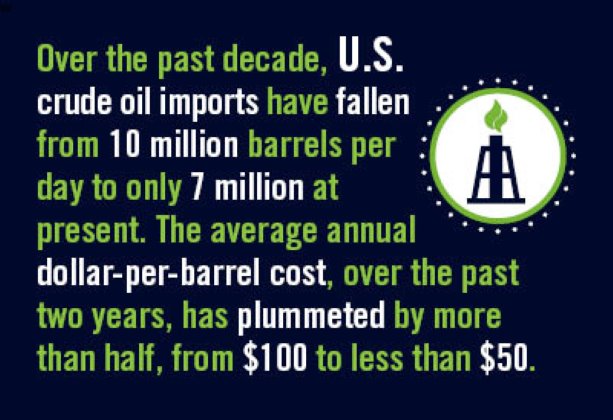The meeting of OPEC’s top officials in Vienna early in December has made it official – the world oil market has become an unfettered free-for-all.
OPEC ministers used to come together with a crude price target in mind and then work towards that goal by setting production limits.
Often those ceilings were largely ignored, but Saudi Arabia – the OPEC member with the most abundant reserves − could be counted on to adjust its output to maintain some degree of pricing stability. For years, that led to $80-to-$100 USD per-barrel oil.
No more. Everyone now has the option to pump as much crude as they like. Since that negates the point of OPEC’s existence, the future of that organization appears cloudy, but therein lies a topic for another different article.
What has changed Saudi thinking so dramatically? That nation’s market share has been put in jeopardy by two seismic shifts in oil markets: (1) conservation efforts around the world that have lowered the trend line of demand for petroleum, partly through promoting the development of ‘renewables’; and (2) expanded oil production by non-OPEC members including Russia, Alberta (i.e., its Oil Sands) and, most significantly, the U.S. hydraulic fracturing sector.
The U.S. international trade in goods and services deficit before the Great Recession routinely ranged between -$600 billion and -$800 billion. Since 2009, it has settled into a better -$400 billion to -$600 billion band.
The smaller negative trade position makes a direct positive contribution to America’s gross domestic product (GDP), also known as its national output.
The improved U.S. trade position is largely thanks to greatly reduced imports of foreign oil, both in terms of volume (i.e., barrels) and price. Graphs 1 through 3 highlight the exceptional changes that have been occurring in the U.S. energy market.
Over the past decade, U.S. crude oil imports have fallen from ten million barrels per day to only seven million at present (Graph 1).
The average annual dollar-per-barrel cost, over the past two years, has plummeted by more than half, from $100 to less than $50 (Graph 2).
The dollar volume of oil imports has plunged from peaks near $350 billion in 2008 and again in 2011 to about $130 billion in 2015, a drop of nearly two-thirds (Graph 3).
There’s a next logical question. To the degree that the U.S. is still importing oil – and that share has fallen to less than 30% of total consumption from above 60% at its maximum – where is it coming from?
Table 1 demonstrates that the major source of U.S. oil imports, by far, is Canada. With a 42% slice year to date through October, it far eclipses second-place Saudi Arabia’s 15%.
Even adding up all OPEC nations yields a 37% stake, which is still less than Canada’s.
The share of all U.S. oil imports supplied by Middle-eastern OPEC nations (i.e., Saudi Arabia, Kuwait and Iraq) is 20%. (By the way, that means the share of grand-total U.S. oil consumption sourced in Middle-eastern OPEC nations is only about 6% (i.e., 20% of 30%).
The revealing statistics hardly stop there.
In terms of number of barrels of oil imported by the U.S., those shipped from Canada so far this year are +8% compared with the same January to October period of last year. The increase in volume has been achieved by means of greater pipeline flow and capacity − despite the ‘stop’ order being placed on the Keystone XL expansion − and tanker traffic over rail lines.
The number of barrels of oil imported into the U.S. originating from OPEC nations has fallen 17% year over year.
That’s also the same extent of decline (-17%) experienced by U.S. imports of oil from Saudi Arabia.
A lesser foreign oil dependency is also altering the passage of goods and services between the U.S. and its major trading partners. Tables 2 and 3 provide insight into new patterns that are emerging.
By a substantial margin, China is the largest supplier of U.S. all-item imports (Table 2).
Next in line are Canada and Mexico, in a virtual tie, with about 13% each.
Mexico, though, is now provisioning the U.S. with far more vehicles and parts than is Canada. (30% of such imports come from Mexico; 17% from Canada.)
Compared with Mexico, Canada’s total trade with the U.S. is more closely tied to energy.
Both Mexico and Canada have seen their currencies decline ‘big time’ in value vis-à-vis the greenback. In Canada’s case, however, that hasn’t been enough to offset the even sharper drop in the price of oil.
As a result, the total value of Canada’s imports into the U.S. has suffered a sharp reversal, -15%. The only other nation, among the Top 10, with a decline so far this year has been Japan, -3%.
There isn’t a single OPEC country among the Top 10 nations providing the U.S. with imports.
Among the Top 10 nations taking U.S. exports (Table 2), Canada remains number one, although Mexico (16%) isn’t far back. China (8%), in third place, may be a more important destination for U.S. foreign sales and shipments than most people are aware.
With respect to the U.S. overall foreign trade deficit, half of it is with China.
Approximate 10% shares belong to each of Germany, Mexico and Japan. The Euro area, which includes Germany, lays claim to 20% of the U.S. trade shortfall.
Here’s a shocker. At this time, U.S. trade with both Canada and with combined OPEC nations is roughly in balance.
Earlier in this Economy at a Glance, some key Canadian trade numbers (e.g., for oil) appeared within the context of the broader American perspective.
Now let’s focus on data from north of the border.
During the period January to October of 2014, the largest sub-component of Canada’s goods exports, by nearly a factor of two compared with motor vehicles and parts, was energy products.
So far this year, with Canadian energy exports -35%, while ‘motor vehicles and parts’ is +15%, the latter category, on a purely dollar volume basis (at $70.4 billion CAD), has nearly caught up with the former (at $72.0 billion CAD).
In the individual month of October, the auto sector ($7.4 billion CAD) provided a higher dollar volume of exports than did the energy sector ($6.3 billion CAD).
Consumer goods exports (also $6.3 billion CAD) were in a dead heat with energy product exports.
Table 4 shows a clear fault line between energy and manufactured-goods exports, with raw-materials-other-than-energy occupying the middle ground.
The big four energy-producing provinces have all seen their fossil fuel exports sink badly so far this year: Alberta, -30%; Saskatchewan, -43%; Newfoundland and Labrador, -40%; and British Columbia, -24%.
Other natural resources, which have also been suffering from reduced world-wide demand, have stumbled as well, but have maintained a measure of respectability.
Exports of metals and minerals are -2% from Ontario, but +2% from Quebec. Thanks to more than acceptable potash demand, they are +44% from Saskatchewan.
B.C. forestry product exports are up a modest 4%. The painfully slow improvement in U.S. housing starts has been a small boon.
Providing generally better export numbers, though, have been aerospace products from Quebec (+13%) and both ‘motor vehicles and parts’ (+12%) and consumer goods (+18%) from Ontario.
There is no escaping the fact the health of Canada’s economy is linked to export success.
Graph 4 shows the present problem in its starkest form. Before the Big Dip, Canada consistently ran impressive trade surpluses each month; since then, there have been deficits more than pluses.
The Canadian economy won’t hit its stride again until the new vertical bars being added to the right-had side of the chart begin to more clearly resemble those on the left-hand side. In other words, they need to be solidly above the ‘zero-valued’ horizontal axis as opposed to descending below it.
The steps that will eventually move Canada in that more encouraging direction include: (1) gains in world trade accompanied by higher commodity prices, especially in oil and gas; and (2) a pick-up in manufacturing export sales as owners spot the opportunities inherent in the lower-valued loonie and commit to greater investments on the maple leaf side of the border.
There is also a crucial number (3) – proceeding with additional capacity to move Canadian primary, secondary and finished products to new markets that are opening up in Asia and elsewhere beyond North America. Yes, that implies a need for pipelines to the coasts.
As seen from Table 5, the Toronto Stock Exchange (TSX) recorded the worst performance (-8.6% year over year) in a comparison with the DJI (-0.6%), S&P 500 (+0.6%) and NASDAQ (+6.6%) at November’s month-end closing.
And that was before OPEC’s decision to pump oil faster, thereby further weakening the price of crude. Also remember that Iran, post-sanctions, will soon be adding to global supplies.
Combine the oil-price effect with a rate hike coming from the Federal Reserve and you have the reasons why both the Canadian dollar and the TSX have been pummeled some more in the first two weeks of December
Jan-Oct 2015
| % Share of Total | ||
| Rank | Country | Number of Barrels |
| 1 | Canada | 41.6% |
| 2 | Saudi Arabia* | 14.7% |
| 3 | Venezuela* | 10.9% |
| 4 | Mexico | 9.6% |
| 5 | Colombia | 5.4% |
| 6 | Ecuador* | 3.3% |
| 7 | Kuwait* | 3.0% |
| 8 | Brazil | 2.8% |
| 8 | Iraq* | 2.6% |
| 10 | Angola* | 1.6% |
| Share of Total Oil Imports | 95.5% | |
Share taken by all OPEC nations is 36.8%.
Share taken by Middle-East OPEC nations, 20.2%.
Chart: CMD.
Table 2: Top 10 Countries Supplying Imports to U.S.
| Jan-Oct, 2015 | % of | % Change versus | ||
| Current $ Billions USD | Grand Total | Jan-Oct 2014 | ||
| 1 | China | $401.9 | 20.5% | 4.6% |
| 2 | Canada | $248.9 | 12.7% | -14.8% |
| 3 | Mexico | $247.5 | 12.6% | 0.6% |
| 4 | Japan | $109.1 | 5.6% | -2.5% |
| 5 | Germany | $103.3 | 5.3% | 0.6% |
| 6 | South Korea | $60.7 | 3.1% | 6.2% |
| 7 | United Kingdom | $49.3 | 2.5% | 8.9% |
| 8 | France | $39.2 | 2.0% | 0.2% |
| 9 | India | $38.5 | 2.0% | 0.1% |
| 10 | Italy | $36.5 | 1.9% | 4.6% |
| Top 10’s Share of Grand Total: | 68.0% | |||
Data source: U.S. Census Bureau.
Chart: CMD.
Table 3: Top 10 Countries Taking Exports from U.S.
| Jan-Oct, 2015 | % of | % Change versus | ||
| Current $ Billions USD | Grand Total | Jan-Oct 2014 | ||
| 1 | Canada | $236.8 | 18.7% | -9.7% |
| 2 | Mexico | $198.9 | 15.7% | -1.5% |
| 3 | China | $95.4 | 7.5% | -4.0% |
| 4 | Japan | $52.8 | 4.2% | -5.8% |
| 5 | United Kingdom | $47.5 | 3.8% | 5.6% |
| 6 | Germany | $41.8 | 3.3% | 0.6% |
| 7 | South Korea | $36.8 | 2.9% | -1.0% |
| 8 | Netherlands | $33.8 | 2.7% | -5.4% |
| 9 | Hong Kong | $30.8 | 2.4% | -10.1% |
| 10 | Belgium | $28.7 | 2.3% | -2.2% |
| Top 10’s Share of Grand Total: | 63.5% | |||
Data source: U.S. Census Bureau.
Chart: CMD.
| % Change, Jan-oct 2015 | |
| Provinces | versus Jan-oct 2014 |
| Newfoundland & Labrador: | |
| Energy products | -39.8% |
| Quebec: | |
| Metals & minerals | 1.2% |
| Aerospace products | 13.3% |
| Ontario: | |
| Metals & minerals | -1.6% |
| Motor vehicles & parts | 12.0% |
| Consumer goods | 18.1% |
| Saskatchewan: | |
| Farm products | -1.3% |
| Energy products | -42.7% |
| Metals & minerals | 44.3% |
| Alberta: | |
| Energy products | -30.4% |
| Petrochemical products | -0.7% |
| British Columbia: | |
| Energy products | -24.2% |
| Forestry products | 3.9% |
Chart: CMD
| INDEX | 52-WEEK LOW | 52-WEEK HIGH | YEAR AGO (NOV 28, 2014) |
MONTH AGO (OCT 30, 2015) |
Latest Month-end Closing Prices (NOV 30, 2015) |
PER CENT CHANGE, LATEST VERSUS |
|||
| 52-WEEK LOW | 52-WEEK HIGH | YEAR AGO | MONTH AGO | ||||||
| Dow Jones Industrials NYSE (^dji) |
Aug 24 15 15,370 |
May 19 15 18,351 |
17,828 | 17,664 | 17,720 | 15.3% | -3.4% | -0.6% | 0.3% |
|
S & P 500 |
Aug 24 15 1,867 |
May 20 15 2,135 |
2,068 | 2,079 | 2,080 | 11.4% | -2.6% | 0.6% | 0.0% |
| NASDAQ (^ixic) |
Aug 24 15 4,292 |
Jul 20 15 5,232 |
4,792 | 5,054 | 5,109 | 19.0% | -2.4% | 6.6% | 1.18% |
| S & P/TSX Composite TSX (^gsptse) |
Aug 24 15 12,705 |
Apr 15 15 15,525 |
14,745 | 13,529 | 13,470 | 6.0% | -13.2% | -8.6% | -0.4% |
Securities Dealers Automated Quotations (NASDAQ), Toronto Stock Exchange (TSE) and Reuters.
Table: CMD.
.











Recent Comments
comments for this post are closed